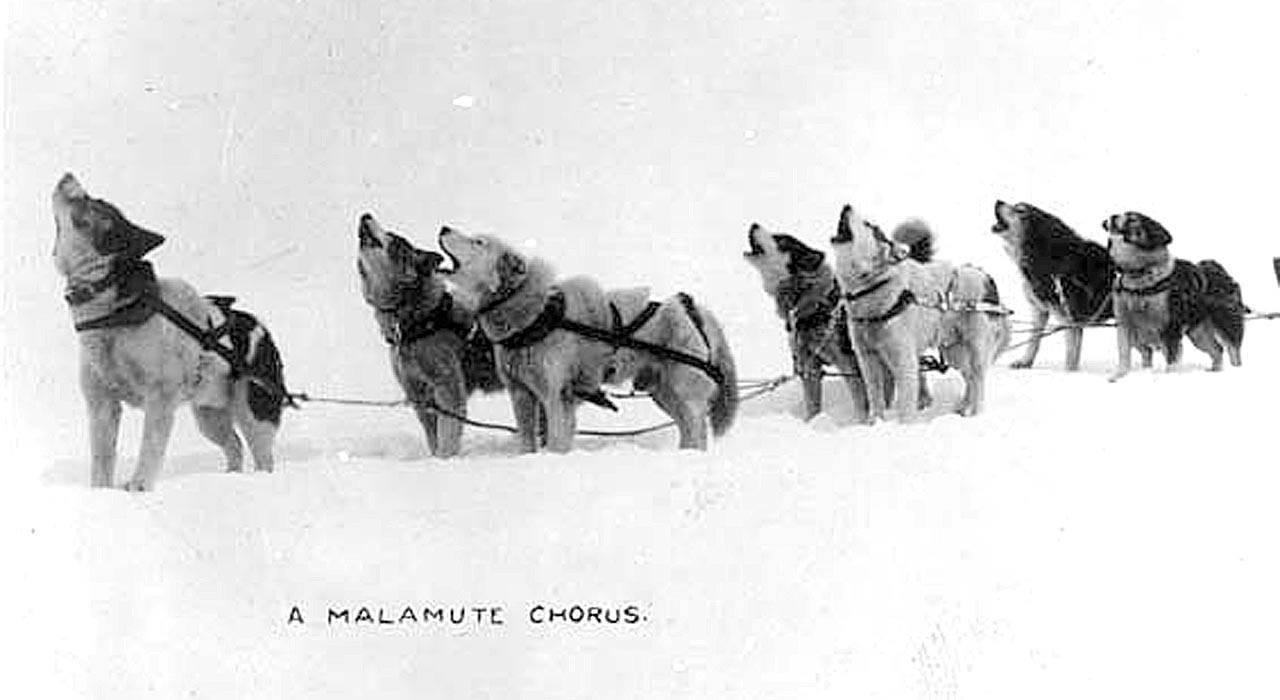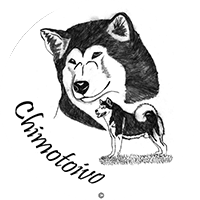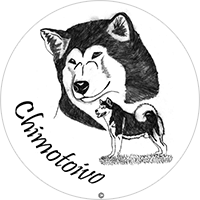History of the Alaskan Malamute
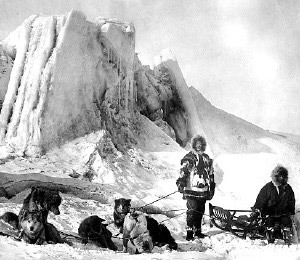 Modern researchers assume that about 2000 to 3000 years ago, great migrations have occurred where people from East Asia moved through the Bering Strait into North America. On their journeys they were accompanied by dogs, which they used as sled dogs hauling freight and help with hunting. The people who moved to North America and Alaska were the ancestors of the Inuit tribe, the Mahlemuts, who settled from Point Barrow to Kotzebue Sound. For centuries they lived here without external interference. People and dogs have adjusted themselves to survive in the most difficult conditions in a rough and raw land, that was for at least nine months a year covered by snow and ice.
Modern researchers assume that about 2000 to 3000 years ago, great migrations have occurred where people from East Asia moved through the Bering Strait into North America. On their journeys they were accompanied by dogs, which they used as sled dogs hauling freight and help with hunting. The people who moved to North America and Alaska were the ancestors of the Inuit tribe, the Mahlemuts, who settled from Point Barrow to Kotzebue Sound. For centuries they lived here without external interference. People and dogs have adjusted themselves to survive in the most difficult conditions in a rough and raw land, that was for at least nine months a year covered by snow and ice.
Here developed the Alaskan Malamute, the oldest indigenous, native american dog. Not bred for beauty according to a certain standard, but suited to pull heavy sleds, able to serve as a hunting dog and with the resistance to survive harsh climatic conditions.
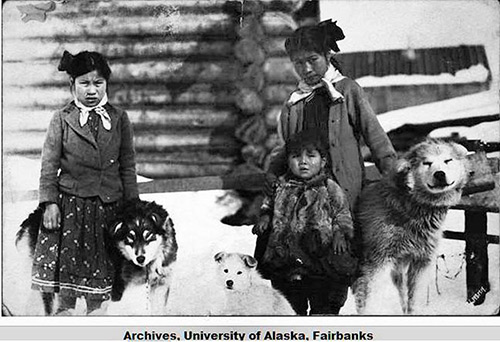 It takes until the 19th century that the stories and writings of seafarers and explorers give a view of life in Alaska. In 1775, the Russians establish a range of trading posts along the southern coast of Alaska. Alexander Mackenzie roams in 1792/1793 along the polar coasts of Alaska. His travel stories and reports indicate that the natives utilized sleds for the transport of large cargo, for which dogs were harnessed.
It takes until the 19th century that the stories and writings of seafarers and explorers give a view of life in Alaska. In 1775, the Russians establish a range of trading posts along the southern coast of Alaska. Alexander Mackenzie roams in 1792/1793 along the polar coasts of Alaska. His travel stories and reports indicate that the natives utilized sleds for the transport of large cargo, for which dogs were harnessed.
The majorty of Inuit tribes consisted of people of short stature, with very tiny hands and feet. An exception was the tribe of the Mahlemuts, which were considerably taller. They were described by both the Russians as well as by later explorers as a highly developed, hard working tribe, that had exceptionally beautiful dogs, who stood by their kind and gentle nature versus man. It is also reported that the Mahlemuts treated and cared better their dogs than other Polar nations, who coped often harsh and even cruel with their dogs.
With the discovery of gold in Alaska in 1896, a flow of gold and fortune seekers enter the country. Many bring their own dogs (St. Bernhard, German Shepherds, Labradors, etc), but soon it becomes clear that these breeds can not withstand the cold and hardships of this unknown land. The demand for snowdogs, in particular Malamautes, became so huge, which results in a short time in each bastard being sold as a real Malamute. When between 1908 and 1918 the sled races becomes popular in Alaska, the decay of the oldest original American breed continues at an accelerated pace; people are breeding the most insane combinations in order to get faster dogs. That we still know the Alaskan Malamute as a breed today, was the work of only a few men between 1920 and 1940. They got their first breeding material from Alaska through sled dog breeders, polar explorers and missionaries on outposts. Because most sled dog breeders in the States back then where in touch with each other, it was possible to get the first couples of Malamutes together.
The first major breeder was Arthur Walden of Chinook Kennel, later Kotzebue Kennel, based in New England. This kennel was taken over in its entirety in 1928 and continued by Mr. & Mrs. Milton Seeley. Still Malamutes are bred under the kennel name Kotzebue. Mrs. Seeley (Eve) made big efforts for the purebred Malamute and thanks to her efforts and her standard, drawn up in 1935, the breed was recognized by the American Kennel Club, and included in a pedigree book.
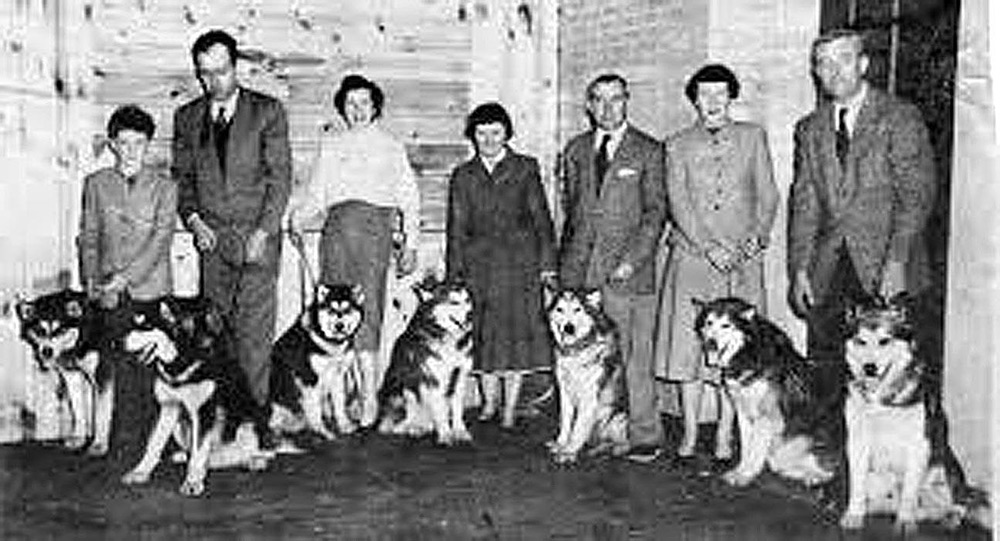 According to this standard the descendants of the Kotzebue line represent the type bestly. It were almost entirely Malamutes of this pedigree that first were registered in the AKC pedigree book. Another very important breeder was Paul Volker, he bred under his kennel name M'loot. He himself did little effort to get the Malamutes bred by him in the AKC-registered pedigree book, but people who bought dogs from him, have ensured that these Malamutes were registered. The M'loot Malamutes were usually larger and heavier than the prescribed standard.
According to this standard the descendants of the Kotzebue line represent the type bestly. It were almost entirely Malamutes of this pedigree that first were registered in the AKC pedigree book. Another very important breeder was Paul Volker, he bred under his kennel name M'loot. He himself did little effort to get the Malamutes bred by him in the AKC-registered pedigree book, but people who bought dogs from him, have ensured that these Malamutes were registered. The M'loot Malamutes were usually larger and heavier than the prescribed standard.
The third name to be mentioned is Dave Irwin. He brought a couple of Malamutes with him from Alaska. Dick Hinman became the owner of their offspring, with which he bred a type with a longer coat than was desired in the standard. The influence of this line is almost completely lost. A single ancestor of the Husky-Pak line of Robert Zoller belonged to this so-called Hindeman Malamutes. Today we find a backlash from this ancestor in sporadically occurring woollies. Until 1940, the Malamute was bred primarily to be used as a sled dog. Many polar expeditions, including both Bird expeditions used besides other pole races, Alaskan Malamutes as draft animals for their sleds. During WWII, army units stationed in the polar regions used large numbers of Malamutes for their transportation. All of these Malamutes were lost, not one returned. When the war ended in 1945, there was such a small amount of Malamutes left, the AKC was forced, under strict terms, to re-open the pedigree book for new subscriptions. Dogs were eligible for enrollment if they were descended from several generations Malamutes and also had proven their value in the show ring by Champion Qualifications. The pedigree was closed again, too early for many. We can assume that all current Malamutes descend from the Kotzebue-line and/or the Malamutes who were enrolled in the end of the forties.
Robert Zoller and his wife Laura Zoller gave a new dimension to the Alaskan Malamute. His quality as working dog didn't had to be proven anymore, but in their opinion the Malamute deserved better than this. They brought the Malamute as a fine house dog to the attention of the enthusiast. In their kennel Husky-Pak, they bred beautiful Malamutes after 1950. Furthermore, Robert Zoller also contributed to the revision of the standard, adopted by the FCI in 1960.
